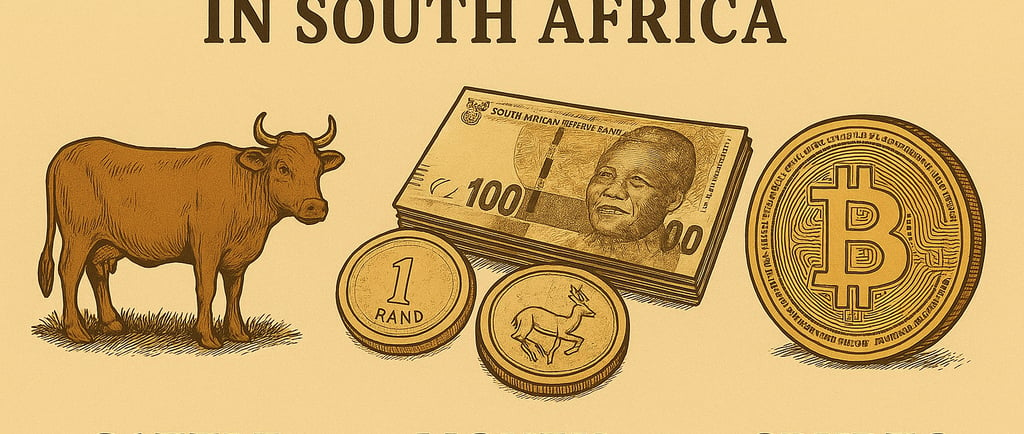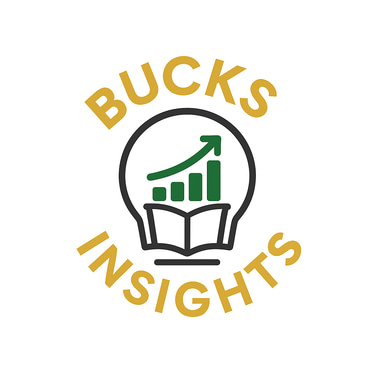From Cows to Crypto: The Story of Money in South Africa
Did you know that long before banknotes and coins, cows were once considered “money” in South Africa? Have you ever wondered what people used as money before cash, bank cards, and mobile banking? The story of money is a fascinating one — a journey from cattle and crops to fiat money, and now even digital currencies.
SOUTH AFRICA GUIDEMONEY BASICS


So, What Exactly Is Money?
At its core, money is simply anything that people agree to use as a medium of exchange. This used to be the standard, before the intervention of the central government and issuance of fiat money. Money allows us to trade goods and services, or settle debts, without needing to barter awkwardly. Instead of saying, “I’ll give you three chickens for your bag of maize”, we now have a common tool — money — to measure and trade value.
Today, that usually means cash. But long before banknotes, money took a very different form.
When Wealth Meant Cows, Not Cash
In the past, wealth wasn’t stored in bank accounts. It lived in the fields and kraals — in crops and livestock. Owning cattle wasn’t just about food; it was about wealth, security, and survival. The more cows you had, the wealthier you were considered.
But managing that kind of wealth wasn’t easy. Cows had to be fed, kept healthy, and protected. Crops had to be planted, fed, kept healthy and harvested at the right time. People invested a lot of effort into maintaining and growing what they owned, just like we do with money today, we work for it, protect it by investing it or saving it, and spend it.
And, just like today, wealth could be passed down. Parents often left livestock or land to their children, ensuring their families had a solid start in life.
What If You Didn’t Inherit Anything?
Not everyone was born into wealth. If you didn’t inherit livestock, you had to earn it. That often meant working for someone who had more resources. Your “salary” wasn’t cash — it might be a cow, a goat, or a portion of crops.
From there, you had to be smart. If you received one cow, your goal was to take care of it until it reproduced. Slowly, one cow could become two, then three, until you had a small herd. Bit by bit, you built your own wealth.
Of course, nature had the final say. Droughts, storms, or harsh winters could wipe out resources overnight. That’s why people relied on planning ahead — harvesting before winter, storing food, and preparing for the lean times.
When Cows Paid Debts
Livestock wasn’t just wealth; it was also currency. Need to repay a debt? A cow could settle it. One well-known tradition still practiced today is lobola, where cattle are given as a form of payment to the bride's family —as part of the gifts that are exchanged during the process of asking that family's daughter to marry you. Back then, there was no concept of “cash in hand” — cattle and crops did the job.
Fast-Forward to Today: The Age of Cash and Cards
Central government formation changed a lot of things, the resources were regulated by the country's elected government. They introduced fiat money or fiat currency. Which is essentially "cash". Then, this cash was stored in bank cards to avoid carrying big bags of cash for the everyday transactions and for the big purchases. This became the modern form of medium of exchange of goods and services. Then, everything revolved around this new money concept (cash) for a long time until the introduction of the new currency, which is now independent of the central government, and this is crypto currency.
Now, everything revolves around cash. If you don’t inherit wealth, you start where many of our ancestors did — by working. Instead of cows, your payment arrives as a salary in your bank account.
People that still have cows, now have options to convert that form of wealth into cash. This obviously comes with convenience and efficiency. Furthermore, people with cash, can convert this into crypto currency. Cash is still one form that can be used in conjunction with any resource at this point. The only limitation with cash is that —it's based on the country's local currency, so this makes it challenging to travel to other countries and use your cash as it is, you will have to purchase that country's currency by selling your country's local currency in exchange of that particular country's currency.
Cash brought convenience, but it also changed the way people viewed money. No longer tied to land or livestock, wealth became numbers on a bank slip. With the rise of credit cards, debit cards, and now mobile banking, money became faster, lighter, and more abstract.
Enter the Digital Era: Cryptocurrencies and Beyond
But the story doesn’t stop there. In recent years, we’ve seen the rise of cryptocurrencies like Bitcoin, Ethereum, and countless others. Just as cows once replaced bartering, and cash replaced cows, digital currencies are now challenging the way we think about money.
Unlike cash, crypto isn’t issued by governments or stored in banks. It exists on decentralized networks called blockchains, which record every transaction securely. Some people see crypto as the “gold of the digital age,” while others use it for everyday trading and investment.
And it doesn’t end with crypto:
Mobile money & digital wallets (like Apple Pay, Google Wallet, and even local options like SnapScan in South Africa) are replacing the need to carry physical cash.
Contactless payments allow us to buy goods with a simple tap of a card or phone.
Central Bank Digital Currencies (CBDCs) are being tested worldwide, where governments issue their own digital versions of money.
Money is no longer just something you can hold in your hand — it’s also something you can store in a digital wallet, invest on a trading app, or send across the world in seconds without touching a single coin.
Lessons From the Past, Applied to the Future
Despite all these changes, one thing has remained the same: the principles of wealth building.
In the past, you started with one cow and grew it into a herd.
Today, you might start with a small savings or a single Bitcoin and grow your portfolio.
Back then, people planned for droughts and harsh winters. Today, we plan for recessions and market downturns.
The tools may change, but the wisdom is timeless: start small, manage wisely, and think long term.
You can read on our article here: The Beginner's Guide To Investing In South Africa
Looking Ahead: The Future of Money
If history has taught us anything, it’s that money will continue to evolve. Just as our ancestors probably couldn’t have imagined debit cards or digital wallets, we might not fully grasp what the next generation of money will look like.
Will artificial intelligence one day manage our wealth automatically?
Will Africa leapfrog into a fully digital economy through mobile money and crypto adoption?
Will we reach a point where “cash” is nothing more than a memory, just like bartering is today?
One thing is certain: whether it’s cattle, cash, or crypto, money will always adapt to the needs of the people. And just as our ancestors did, it’s up to us to use it wisely, grow it carefully, and pass it on to the generations to come. You can read on our article here: Generational Wealth: Creating, Growing, and Passing It On
